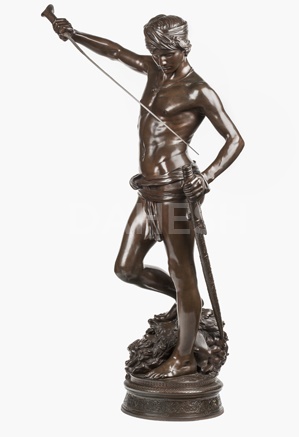Marius Jean Antonin Mercié (French, 1845–1916)
David, ca. 1872
Bronze, brown patina, 25 1/2 x 12 3/4 x 17 7/8 in.
Signed on base top right: A. MERCIÉ
Stamped on base at side back center: REDUCTION MECANIQUE A. COLLAS BREVETÉ
Gift of Tracy and Laurel Pulvers
2014.4

Mercié, one of the most successful sculptors of late 19th- and early 20th-century France, began as a pupil of François Jouffroy and Alexandre Falguière at the École des Beaux-Arts in Paris. He won the Prix de Rome in 1868 and found immediate success with the first plaster model of David that he executed while in Rome. The sculpture symbolized a glimmer of hope for France after its crushing defeat by Prussia. David, armed with a slingshot, brought down the giant Goliath, proving that France too could triumph over its enemy. The State awarded Mercié the Legion of Honor for the work, making him the only artist to receive this distinction while still a student at the French Academy. In 1872 the state commissioned a bronze version of David (Musée d’Orsay), and the Barbedienne foundry cast a miniature version, in six different sizes. The work was widely praised by critics and even caught the attention of Cézanne, who drew the statue on the back of a sketchbook page.


